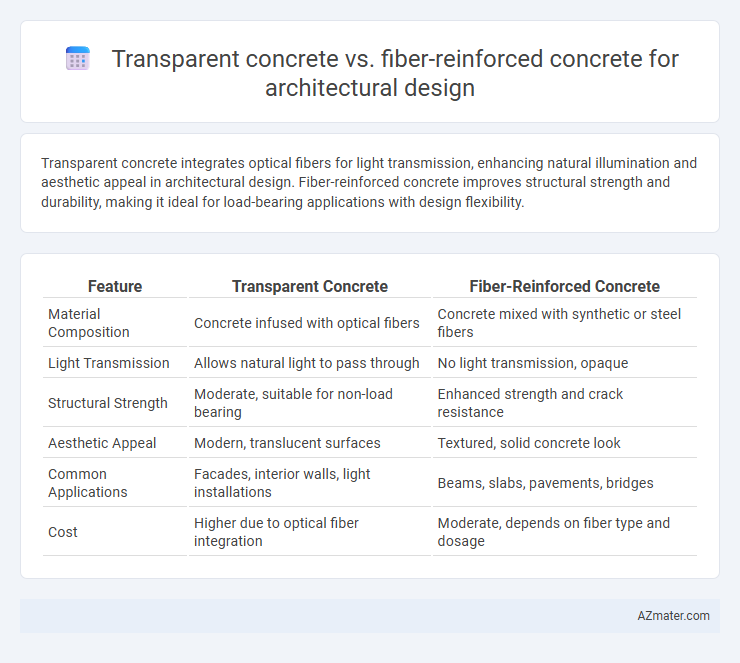Transparent concrete integrates optical fibers for light transmission, enhancing natural illumination and aesthetic appeal in architectural design. Fiber-reinforced concrete improves structural strength and durability, making it ideal for load-bearing applications with design flexibility.
Table of Comparison
| Feature | Transparent Concrete | Fiber-Reinforced Concrete |
|---|---|---|
| Material Composition | Concrete infused with optical fibers | Concrete mixed with synthetic or steel fibers |
| Light Transmission | Allows natural light to pass through | No light transmission, opaque |
| Structural Strength | Moderate, suitable for non-load bearing | Enhanced strength and crack resistance |
| Aesthetic Appeal | Modern, translucent surfaces | Textured, solid concrete look |
| Common Applications | Facades, interior walls, light installations | Beams, slabs, pavements, bridges |
| Cost | Higher due to optical fiber integration | Moderate, depends on fiber type and dosage |
Introduction to Innovative Concrete Solutions
Transparent concrete incorporates optical fibers to allow light transmission, creating visually striking architectural elements that enhance natural lighting and aesthetic appeal. Fiber-reinforced concrete integrates synthetic or steel fibers to improve tensile strength, durability, and crack resistance, offering structural benefits in complex designs. Both materials represent innovative concrete solutions revolutionizing architectural possibilities by combining functional performance with creative expression.
What is Transparent Concrete?
Transparent concrete is a composite building material that incorporates optical fibers or light-transmitting elements, allowing natural light to pass through while maintaining structural integrity. In architectural design, it offers innovative aesthetic possibilities by combining durability with translucency, enabling illuminated walls and facades without compromising strength. This material contrasts with fiber-reinforced concrete, which primarily enhances mechanical properties through embedded fibers without light transmission capabilities.
What is Fiber-Reinforced Concrete?
Fiber-reinforced concrete (FRC) is a composite material composed of conventional concrete embedded with fibrous materials such as steel, glass, synthetic, or natural fibers to enhance its structural performance and durability. This innovative concrete variant improves tensile strength, crack resistance, and impact absorption, making it ideal for architectural designs requiring enhanced load-bearing capacity and long-term resilience. Compared to transparent concrete, which incorporates optical fibers for light transmission, FRC emphasizes mechanical reinforcement and structural integrity in architectural applications.
Key Material Properties Comparison
Transparent concrete exhibits high light transmittance due to embedded optical fibers, enabling innovative daylighting and aesthetic effects in architectural design. Fiber-reinforced concrete enhances tensile strength, crack resistance, and durability by incorporating steel, glass, or synthetic fibers, making it ideal for structural applications requiring improved mechanical performance. Both materials improve architectural versatility, with transparent concrete prioritizing visual impact and fiber reinforcement focusing on enhanced load-bearing properties.
Structural Performance and Load-Bearing Capacity
Transparent concrete incorporates optical fibers to transmit light while maintaining moderate compressive strength, typically around 30-50 MPa, making it suitable for non-load-bearing architectural elements that emphasize aesthetics and natural illumination. Fiber-reinforced concrete uses embedded fibers such as steel, glass, or synthetic materials to significantly enhance tensile strength, ductility, and crack resistance, often achieving compressive strengths exceeding 50 MPa, supporting load-bearing structural components in complex architectural designs. The choice between transparent and fiber-reinforced concrete depends on project priorities, where transparent concrete optimizes light diffusion with limited structural capacity, and fiber-reinforced concrete prioritizes superior load-bearing performance and durability.
Architectural Aesthetics and Design Potential
Transparent concrete enhances architectural aesthetics by incorporating optical fibers or light-transmitting elements, allowing natural or artificial light to permeate structural components and create dynamic lighting effects that enrich spatial experiences. Fiber-reinforced concrete offers design potential through improved mechanical properties such as tensile strength and crack resistance, enabling slender, innovative forms and complex geometries that maintain structural integrity. Combining transparency with fiber reinforcement can push the boundaries of architectural design by merging visual lightness with durability and versatility.
Light Transmission vs Strength Enhancement
Transparent concrete incorporates optical fibers or light-transmitting elements, enabling natural light to pass through structural components while maintaining moderate load-bearing capacity. Fiber-reinforced concrete significantly enhances strength and durability by embedding steel, glass, or synthetic fibers but does not support light transmission. Architectural design decisions prioritize transparent concrete for aesthetic illumination effects and fiber-reinforced concrete for structural resilience and impact resistance.
Durability and Long-Term Maintenance
Transparent concrete offers moderate durability with embedded optical fibers or resin-based materials that maintain aesthetic translucency but may degrade under prolonged UV exposure and mechanical stress. Fiber-reinforced concrete significantly enhances structural integrity and crack resistance due to the distribution of synthetic or steel fibers, reducing long-term maintenance requirements by minimizing surface wear and structural damage. For architectural designs requiring both visual appeal and robust, low-maintenance performance, fiber-reinforced concrete provides superior longevity compared to transparent concrete.
Sustainability and Environmental Impact
Transparent concrete offers unique aesthetic benefits and daylight transmission while maintaining structural integrity, using optical fibers embedded in cement composites to reduce artificial lighting needs and enhance energy efficiency. Fiber-reinforced concrete improves durability and crack resistance by incorporating synthetic or natural fibers, leading to longer service life and reduced material consumption, which lowers the environmental footprint. Both materials contribute to sustainable architectural design by optimizing resource use, minimizing energy demand, and supporting eco-friendly construction practices.
Selecting the Right Concrete for Architectural Needs
Transparent concrete integrates optical fibers or light-transmitting elements to create illuminated architectural surfaces, enhancing aesthetic appeal and natural lighting. Fiber-reinforced concrete incorporates steel, glass, or synthetic fibers to improve structural strength, crack resistance, and durability, supporting load-bearing and functional designs. Selecting the right concrete depends on balancing visual effects with mechanical performance, where transparent concrete suits decorative facades and fiber-reinforced concrete meets rigorous structural requirements.

Infographic: Transparent concrete vs Fiber-reinforced concrete for Architectural design
 azmater.com
azmater.com